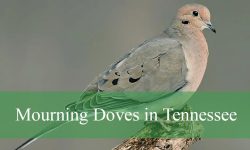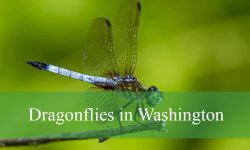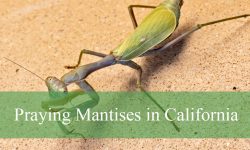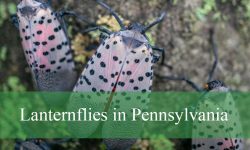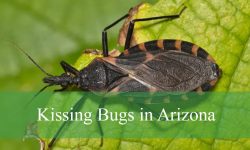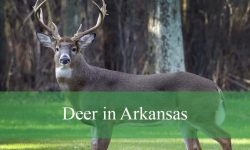Louisiana is famous for its vast wetlands, rivers, and coastal marshes that provide ideal homes for many species of waterfowl. The state attracts a diverse range of waterfowl in Louisiana all year round, from colorful ducks to majestic geese. This variety makes Louisiana a top spot for birdwatching and wildlife photography.
Waterfowl in Louisiana include both permanent residents and seasonal migrants that come to the region during the colder months. These birds add beauty and life to the landscape and play important roles in maintaining healthy ecosystems. Exploring the wetlands and lakes reveals many opportunities to observe these fascinating waterfowl up close.
This article introduces the top 25 waterfowl in Louisiana, offering detailed pictures and identification tips. The guide will help bird enthusiasts of all levels recognize key features and learn interesting facts about each species found throughout the state.
Common Waterfowl Found in Louisiana
Blue-winged Teal (Spatula discors)
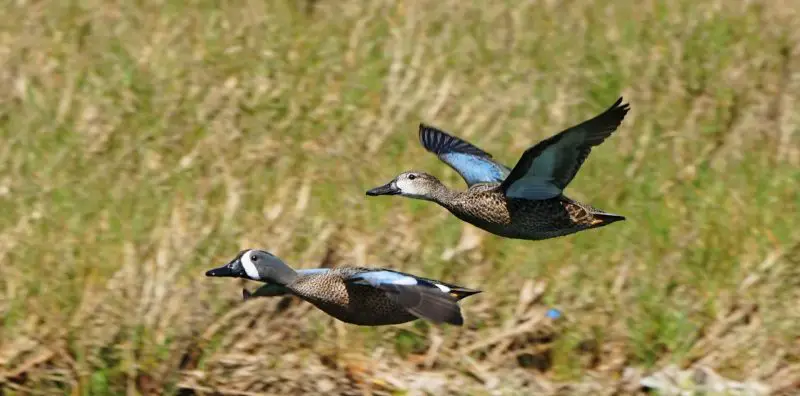
The Blue-winged Teal is a small dabbling duck easily recognized by its striking plumage. Males have a bold white crescent on their face, a bluish-gray head, and a speckled brown body. Females are mottled brown and more subtly colored, but both sexes display light blue patches on their upper wings, which are visible in flight. Their wings also have a green speculum bordered with white.
This species is particularly abundant during migration seasons—fall and spring—in Louisiana. During these times, Blue-winged Teals gather in large numbers in freshwater wetlands, rice fields, and shallow ponds. Their early migration makes them one of the first ducks to arrive in fall and among the first to leave in spring.
Blue-winged Teals are among the smallest North American ducks, measuring around 14–16 inches (35–41 cm) in length with a wingspan of about 23 inches (58 cm). They are agile fliers and often appear in small, tight flocks that dart quickly over water or vegetation. Their calls include soft, high-pitched whistles, particularly from males during courtship.
Their diet primarily consists of seeds, aquatic vegetation, and small invertebrates such as snails and insects. In Louisiana, they often forage in flooded rice fields and shallow marshes, using their bills to filter food from the water. Their preference for shallow, calm wetlands makes them a frequent sight in managed impoundments and natural marshlands throughout the state.
Gadwall (Mareca strepera)
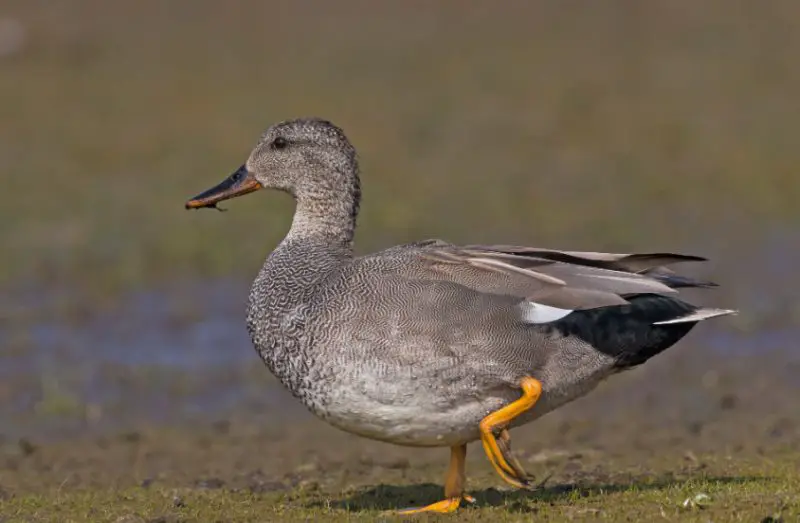
The Gadwall is a medium-sized dabbling duck with a more subdued appearance than many other species. Males are mostly gray with a black rear end and a distinctive white patch on the wing that is visible in flight. Females resemble female Mallards but are generally more uniform in color and lack the blue wing patch.
In Louisiana, Gadwalls are widely distributed during the winter months. They are especially common in freshwater marshes, flooded timber, and coastal wetlands. Their tendency to congregate in both inland and coastal habitats makes them one of the most frequently observed ducks in the region during colder months.
Adult Gadwalls typically measure about 19–22 inches (48–56 cm) in length and have a wingspan of 33 inches (84 cm). They are strong, fast fliers and often form medium-sized flocks. Unlike more colorful ducks, their understated appearance helps them blend into marsh vegetation, which offers them both camouflage and protection.
Gadwalls primarily feed on aquatic vegetation such as pondweed, algae, and grasses. They are also known to steal food from diving ducks and coots. In Louisiana, they forage in both shallow freshwater and brackish environments, often tipping forward in the water to graze submerged plants.
Northern Shoveler (Spatula clypeata)
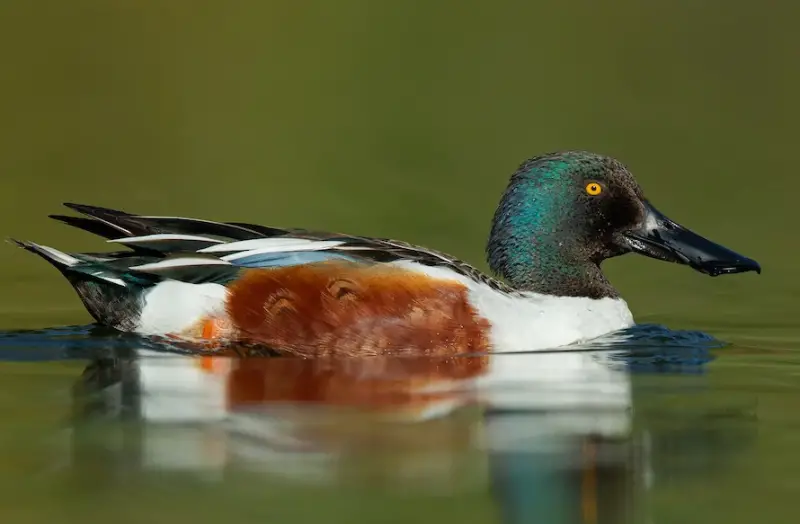
The Northern Shoveler stands out easily due to its large, spoon-shaped bill, which is wider at the tip than at the base. Males in breeding plumage display a dark green head, white chest, and chestnut sides, while females are mottled brown with an orange spatulate bill. This unique bill is perfectly adapted for filtering tiny food particles from the water.
In Louisiana, this species is commonly seen in shallow wetlands, flooded fields, and rice paddies. It is particularly abundant in the Mississippi Alluvial Valley and coastal marshes during the winter migration period. They often occur in loose flocks and are sometimes seen in mixed groups with other dabbling ducks.
Northern Shovelers are medium-sized ducks, measuring 17–20 inches (43–51 cm) in length with a wingspan of about 30 inches (76 cm). Their flight is fast and direct, with their wings making a distinct whistling sound. They are known for their spinning behavior, swimming in circles to stir up food.
Their diet mainly includes small aquatic invertebrates, plankton, and seeds. Using their comb-like bill structures, they skim food from the water surface or just below it. In Louisiana’s wetlands and shallow flooded areas, they feed actively throughout the day and are often seen dabbling alongside other duck species.
Green-winged Teal (Anas crecca)
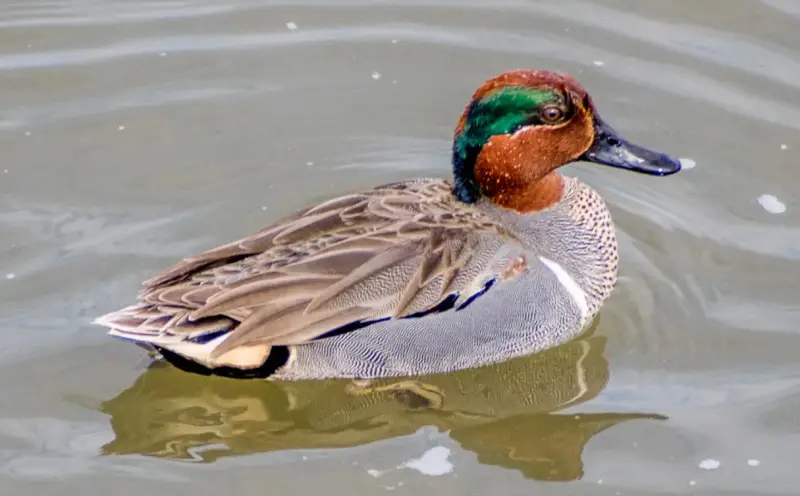
The Green-winged Teal is one of the smallest dabbling ducks in North America, yet it is remarkably colorful. Males are easily identified by their chestnut heads with a vivid green stripe running from the eye to the neck, and grayish bodies. Females are brown and mottled, similar to other female ducks, but both sexes show a bright green wing patch in flight.
This species is among the most numerous ducks found in Louisiana during winter. They prefer shallow wetlands, flooded rice fields, and marshes across both northern and southern parts of the state. Their small size allows them to use narrower and shallower water bodies than many other ducks.
Green-winged Teals are compact, measuring about 12–15 inches (31–38 cm) in length with a wingspan of approximately 23 inches (58 cm). Despite their size, they are fast and agile fliers, often taking off in tight groups with rapid wingbeats. Their call is a high-pitched whistle, especially noticeable among males.
They primarily consume seeds of grasses and sedges, aquatic insects, and small crustaceans. In Louisiana, they feed in shallow pools and mudflats, using their bills to dabble and tip-up. They are commonly observed in flooded agricultural lands, including rice and soybean fields, where food is plentiful in winter months.
Mallard (Anas platyrhynchos)
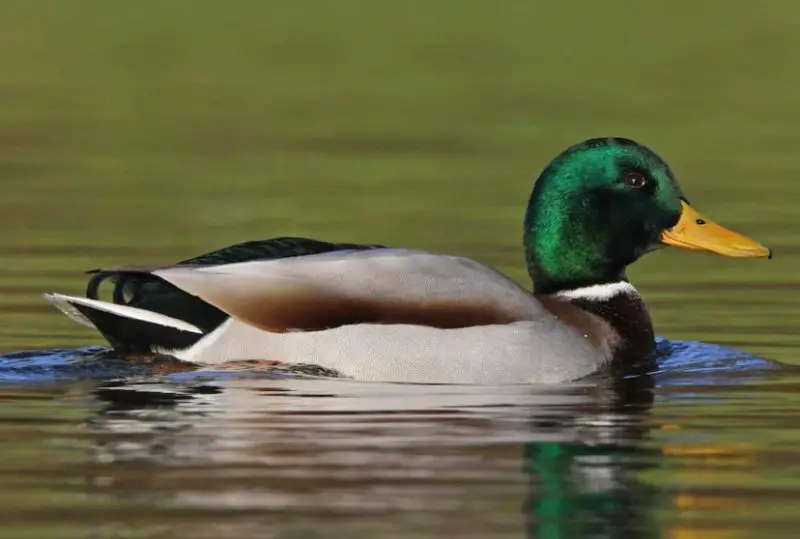
The Mallard is perhaps the most familiar and widespread duck in North America. Males are striking with their iridescent green heads, white neck rings, and bright yellow bills, while females are brown and streaked with an orange bill marked with black. Both sexes have a noticeable blue speculum edged with white on their wings.
In Louisiana, Mallards are common across both northern and southern regions, especially near freshwater environments. They can be found in lakes, ponds, flooded woods, and rice fields. Their adaptability makes them one of the most versatile waterfowl species in the state.
Adult Mallards are large dabbling ducks, measuring 20–26 inches (50–66 cm) in length with a wingspan of up to 39 inches (99 cm). They are strong fliers and often travel in small groups or pairs. Mallards are also quite vocal; the classic “quack” is most often associated with the female.
Mallards have an omnivorous diet that includes seeds, acorns, aquatic plants, and invertebrates. In Louisiana, they forage in flooded timber, marshes, and agricultural areas, especially where grain is available. Their ability to thrive in both wild and urban settings makes them a prominent species throughout the region.
Northern Pintail (Anas acuta)
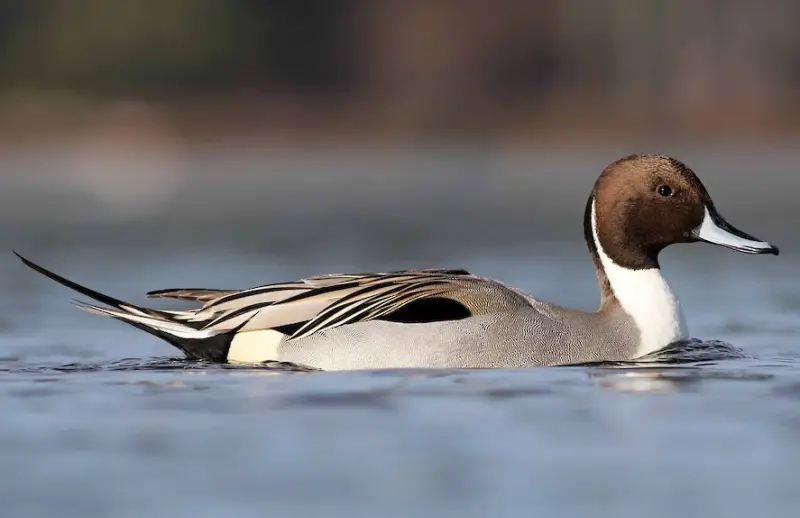
The Northern Pintail is an elegant dabbling duck with a long, pointed tail and sleek body. Males are easily identified by their chocolate-brown heads, white necks, and graceful gray bodies, with a distinctive long tail feather that gives them their name. Females are more modestly colored in mottled brown, but also show a slender profile and longer neck than many other ducks.
In Louisiana, Northern Pintails are often seen in large flocks during the winter months. They prefer open, shallow wetlands such as flooded rice fields, coastal marshes, and freshwater impoundments. Their preference for wide, open water bodies makes them a common sight in agricultural and natural wetland landscapes.
Northern Pintails measure between 20–30 inches (51–76 cm) in length, with a wingspan of up to 35 inches (89 cm). They are agile and fast fliers, often seen in tight V-formations when moving between feeding and roosting sites. Their soft, whistling calls are most frequently heard during the winter and spring months.
Their diet consists primarily of seeds, aquatic vegetation, and small invertebrates. In Louisiana’s wetland habitats, they often forage by dabbling or tipping forward in shallow water. They are particularly attracted to flooded croplands where leftover grain offers an abundant winter food source.
American Wigeon (Mareca americana)
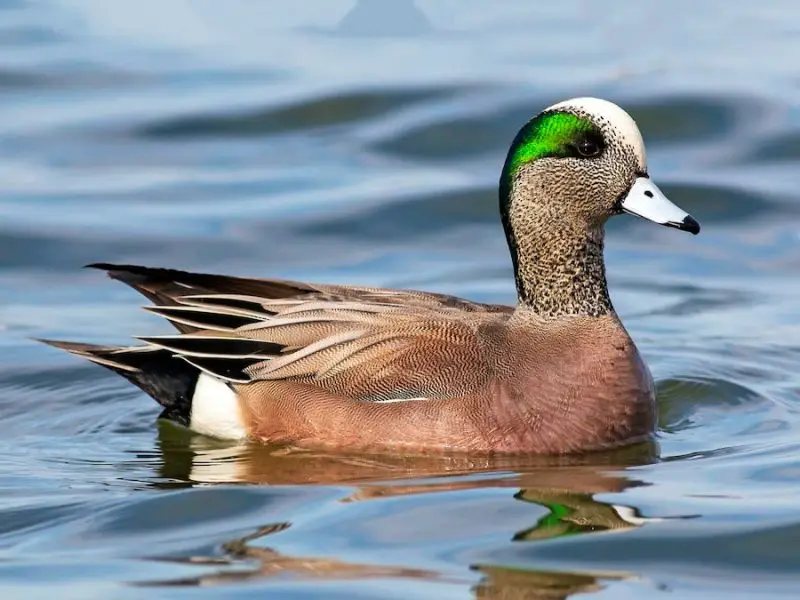
The American Wigeon is a medium-sized dabbling duck with a compact build and a short bill. Males are distinctive with a white crown, green eye patch, and brownish body. Females are grayish-brown with a dark smudge around the eye. Both sexes have a white wing patch visible in flight and a whistling call that gives them the nickname “baldpate.”
In Louisiana, American Wigeons are most common during the winter months. They are frequently seen in shallow marshes, flooded grasslands, and agricultural fields, especially where aquatic vegetation is abundant. Their numbers often peak during January and February in the Mississippi Flyway.
Adult wigeons measure about 17–23 inches (43–59 cm) in length with a wingspan of around 33 inches (84 cm). They are social birds and often gather in large, mixed-species flocks. Their flight is swift and direct, and they are among the more vocal of the dabbling ducks.
Their diet is mostly vegetarian, feeding heavily on aquatic plants, grasses, and occasionally seeds. Unlike many other dabbling ducks, American Wigeons often graze on land and will even steal food from diving birds such as coots. In Louisiana, they are frequently seen feeding in shallow freshwater areas rich in submerged vegetation.
Snow Goose (Anser caerulescens)
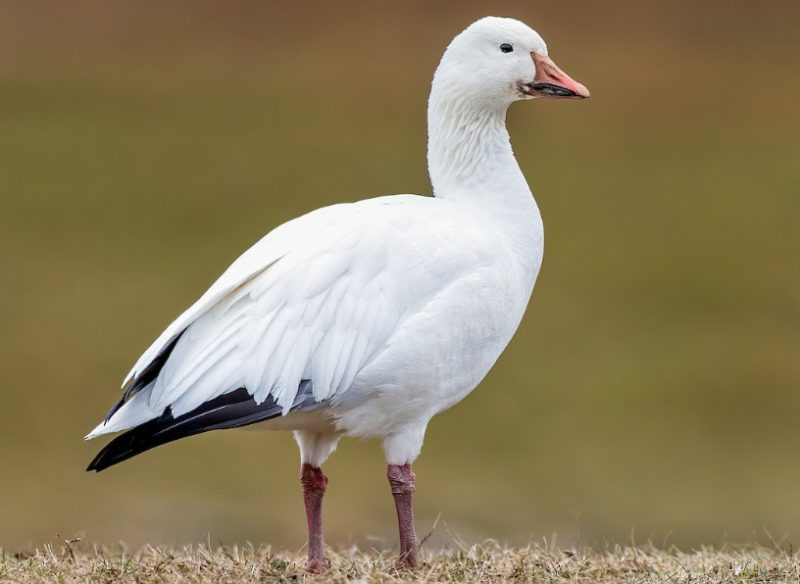
The Snow Goose is a highly social and abundant goose, especially during migration and winter. There are two color morphs: the white morph, which is mostly white with black wingtips, and the blue morph, which has a dark gray-blue body and white head. Both morphs have pink bills and legs and are often seen together in large flocks.
In Louisiana, Snow Geese are extremely common in winter, especially in the northeast and central parts of the state. They gather in the tens of thousands in open fields, shallow wetlands, and agricultural lands, particularly where rice and corn are grown. Their loud honking calls and massive flocks are a signature sound and sight of the Louisiana winter landscape.
Snow Geese are large birds, measuring about 25–32 inches (64–81 cm) in length with a wingspan of up to 54 inches (137 cm). Their migration is among the most spectacular of any North American bird, with dense flocks forming twisting, undulating patterns in the sky. They are strong fliers and often travel long distances between feeding areas.
Their diet consists mostly of plant material—grasses, roots, and waste grains. In Louisiana, they forage in harvested fields, mudflats, and shallow freshwater areas. They often use their bills to dig up roots and tubers, sometimes damaging crops, which makes them both admired and managed carefully in certain agricultural zones.
Black-bellied Whistling Duck (Dendrocygna autumnalis)
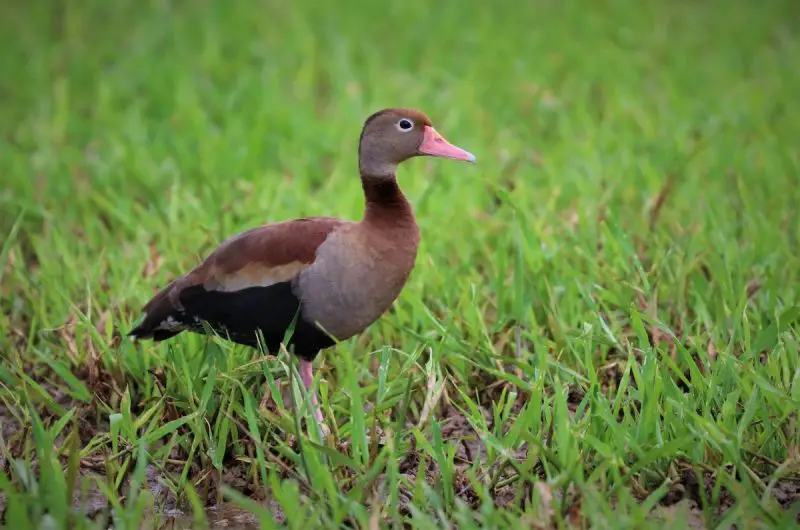
The Black-bellied Whistling Duck is a striking, long-legged duck with a tall, upright posture and a bright pink bill. Adults are chestnut-brown with a black belly, gray face, and broad white wing patch visible in flight. Their name comes from their distinctive whistling calls, often heard even in flight or at night.
This species is unique among ducks in that it is a year-round resident in southern Louisiana. It has expanded its range northward in recent decades and is now a common breeding bird in the southern portion of the state. Black-bellied Whistling Ducks are often seen perched in trees or on utility poles, which is unusual for waterfowl.
They are medium-sized ducks, measuring about 18–21 inches (46–53 cm) long with a wingspan of about 37 inches (94 cm). Their flight is strong and direct, and their social behavior includes forming tight family groups. Their calls are high-pitched and musical, contributing to their lively presence in local wetlands.
Their diet includes seeds, aquatic plants, and invertebrates. In Louisiana, they are commonly observed feeding in rice fields, marshes, and flooded woodlands. They also frequently visit backyard feeders, especially in suburban areas near water. Their bold behavior and adaptability have made them increasingly noticeable in both rural and urban environments.
Ring-necked Duck (Aythya collaris)
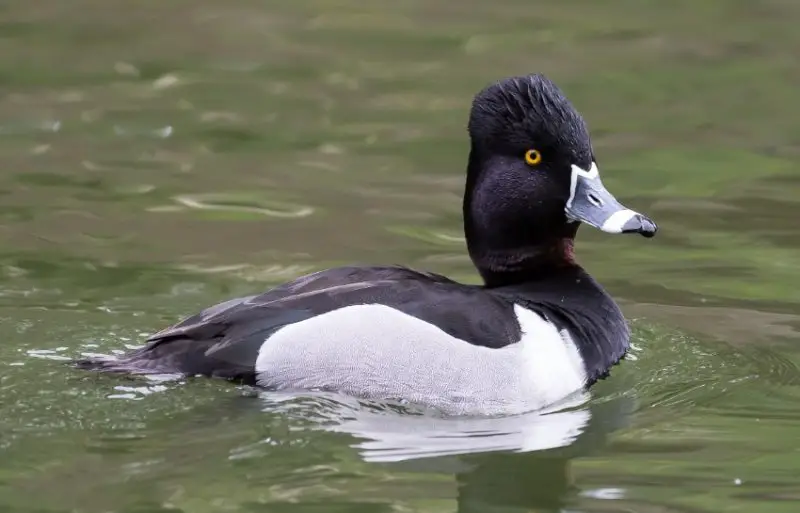
The Ring-necked Duck is a diving duck known for its compact build and distinctive head shape. Males are black and gray with a prominent black back, white ring around the bill, and subtle chestnut ring around the neck, which is often hard to see. Females are brown with a lighter face and a white eye ring and bill base.
In Louisiana, Ring-necked Ducks are among the most common diving ducks found on freshwater lakes, reservoirs, and flooded timber during winter. They often form small to medium-sized flocks and prefer calm, protected waters. Their numbers tend to peak in late winter, especially in north-central and southwestern parts of the state.
These ducks are medium-sized, measuring about 15–18 inches (38–46 cm) in length with a wingspan of 24–29 inches (61–74 cm). They are strong swimmers and take off quickly from the water with fast wingbeats. Though not as vocal as dabbling ducks, they produce low grunts and soft whistles.
Ring-necked Ducks primarily feed on submerged vegetation, seeds, and aquatic invertebrates. They dive to forage on the lake bottom or among aquatic plants. In Louisiana, they are especially attracted to cypress-tupelo swamps, reservoirs, and managed impoundments where food is plentiful and water is deep enough for diving.
Lesser Scaup (Aythya affinis)
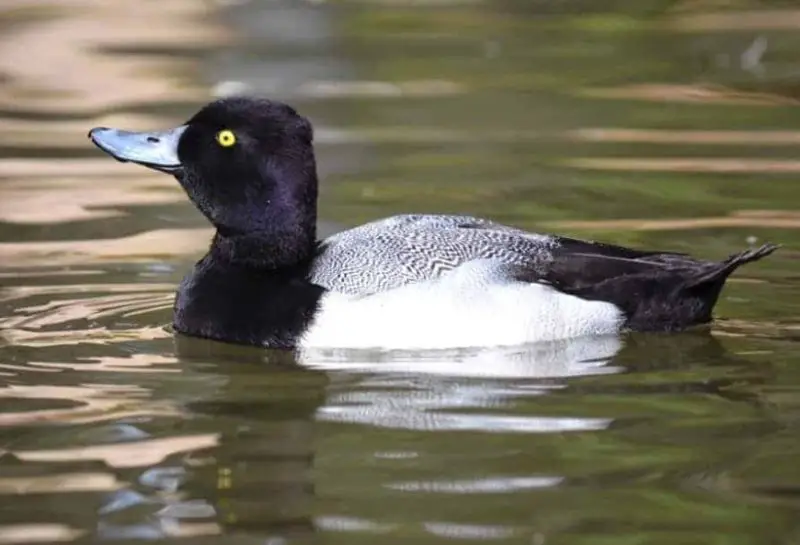
The Lesser Scaup is a medium-sized diving duck with a rounded head and striking blue-gray bill. Males have black heads with a purplish sheen, a black chest, gray back, and white flanks, while females are brown with a distinctive white patch at the base of the bill. They are often confused with the Greater Scaup, but have subtler features and a more peaked crown.
In Louisiana, Lesser Scaups are frequently seen in large flocks on lakes, reservoirs, and sheltered coastal bays during winter. They prefer open water and are especially abundant in large freshwater bodies and estuaries along the Gulf Coast. They are often observed in mixed flocks with other diving ducks.
Lesser Scaups measure about 15–18 inches (38–46 cm) in length with a wingspan of approximately 26–31 inches (66–79 cm). They are swift fliers and strong divers, capable of reaching depths to forage for food. While they are generally quiet, males produce soft, raspy whistles during courtship.
Their diet includes aquatic invertebrates such as snails, clams, and insect larvae, as well as submerged plant matter. In Louisiana, they feed primarily by diving in deeper lakes and coastal lagoons, using their strong legs and webbed feet to propel themselves underwater.
Redhead (Aythya americana)
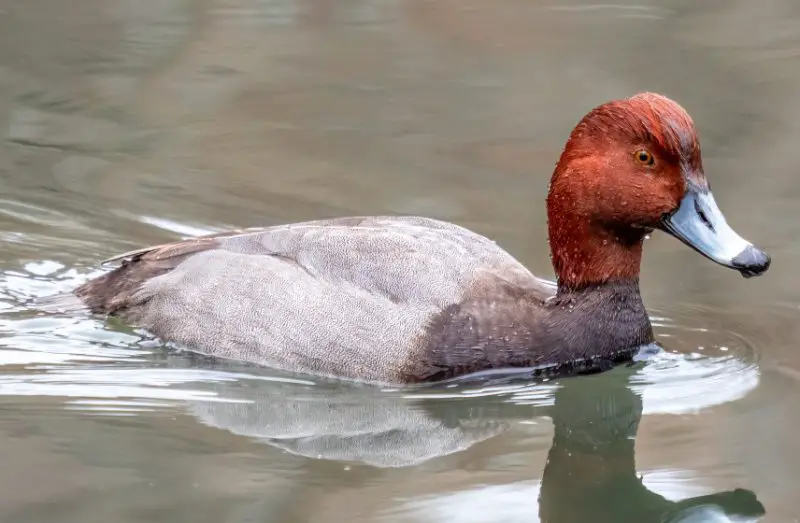
The Redhead is a robust diving duck known for the male’s rich reddish head, black chest, and gray body. Females are a warm brown with a lighter face and pale eye ring. Both sexes have a blue-gray bill with a black tip, giving them a clean, elegant appearance when seen up close.
In Louisiana, Redheads are common winter residents, particularly on large inland lakes and coastal lagoons. They are often found in sheltered bays, brackish marshes, and impounded wetlands where food is abundant. Redheads frequently gather in large flocks, often mingling with other diving duck species.
These ducks measure 18–22 inches (46–56 cm) long with a wingspan of about 30–34 inches (76–86 cm). Their flight is fast and direct, and they often take off in groups with a noisy splash. On water, they float low and appear calm, often diving to feed in deeper wetlands.
Redheads feed primarily on submerged vegetation like pondweeds and wild celery, but also consume aquatic invertebrates. In Louisiana, they are frequently seen diving in coastal marshes and freshwater lakes, where they forage on underwater plant roots and tubers.
Mottled Duck (Anas fulvigula)
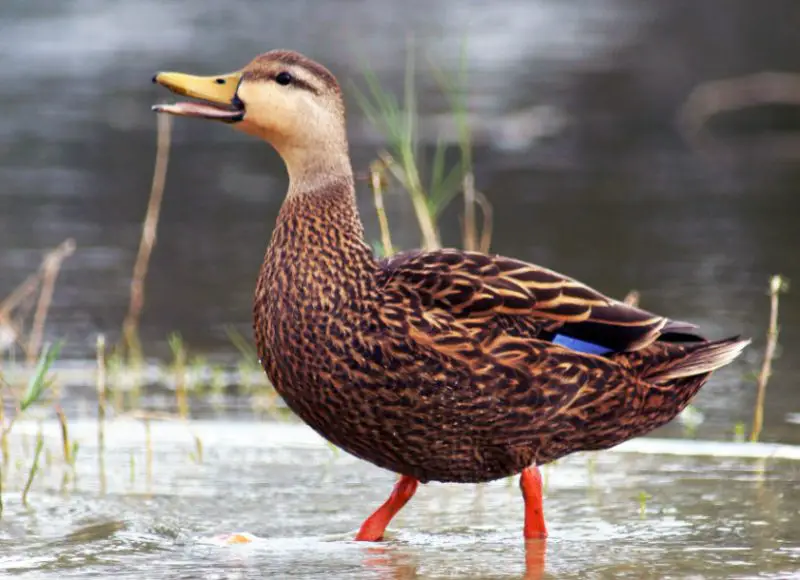
The Mottled Duck is a medium-sized dabbling duck that closely resembles a female Mallard but lacks the white tail borders and bright speculum edging. Both sexes have a uniformly mottled tan and brown appearance, with a dark eye stripe and slightly iridescent blue-green wing patches. Males have brighter yellow bills, while females tend to have more orange.
This species is non-migratory and found year-round in southern Louisiana, particularly in coastal marshes and brackish wetlands. Mottled Ducks are one of the few duck species that are native to the Gulf Coast, and they are especially common in the Mississippi River Delta and nearby estuarine habitats.
Mottled Ducks are roughly 20 inches (51 cm) long with a wingspan of about 33 inches (84 cm). They are strong but somewhat reluctant fliers and are usually seen alone or in small groups. Their quiet quacks and secretive behavior make them less conspicuous than other dabbling ducks.
Their diet consists mostly of aquatic plants, seeds, and small invertebrates. In Louisiana, they forage in shallow marshes, flooded rice fields, and tidal flats. Because they do not migrate, they are more vulnerable to habitat changes and hybridization with feral Mallards, which is a conservation concern in the region.
Fulvous Whistling Duck (Dendrocygna bicolor)
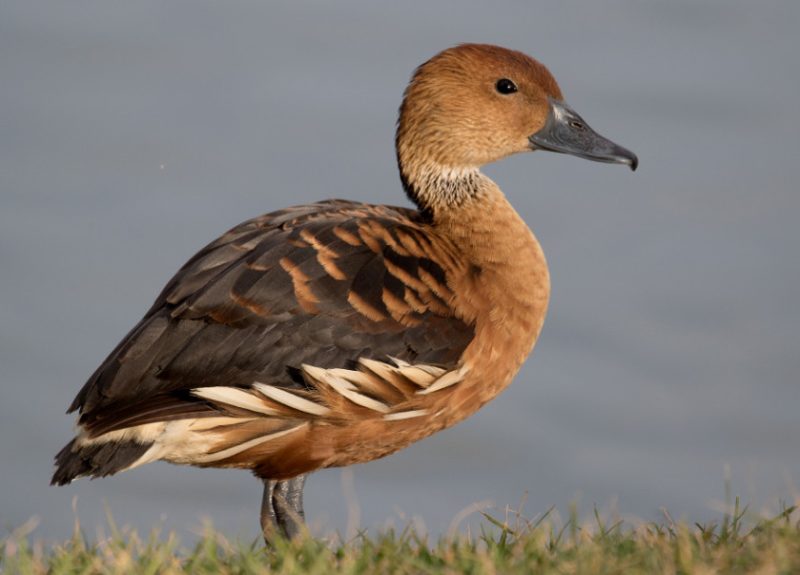
The Fulvous Whistling Duck is a tall, lanky waterfowl with long legs, a slender neck, and a cinnamon-colored body. It features bold black markings on the back and a pale face and bill. Like its close relative the Black-bellied Whistling Duck, it stands upright and has a graceful, almost goose-like appearance.
In Louisiana, Fulvous Whistling Ducks are less common than Black-bellied but still regularly observed in southern marshes, particularly in the southwestern rice-growing region. They are primarily summer residents, though some individuals may remain through mild winters in southern parts of the state.
These ducks are about 18–21 inches (46–53 cm) long with a wingspan of roughly 37 inches (94 cm). They are strong fliers and often travel in pairs or family groups. Their high-pitched, two-note whistle is a familiar sound in quiet marshes and rice fields where they feed and nest.
Their diet includes seeds, aquatic vegetation, and small insects. In Louisiana, they are often found in flooded agricultural fields, especially those with rice and millet. They forage by wading and occasionally dabbling on the surface, and they often nest on the ground amid dense vegetation.
Canada Goose (Branta canadensis)
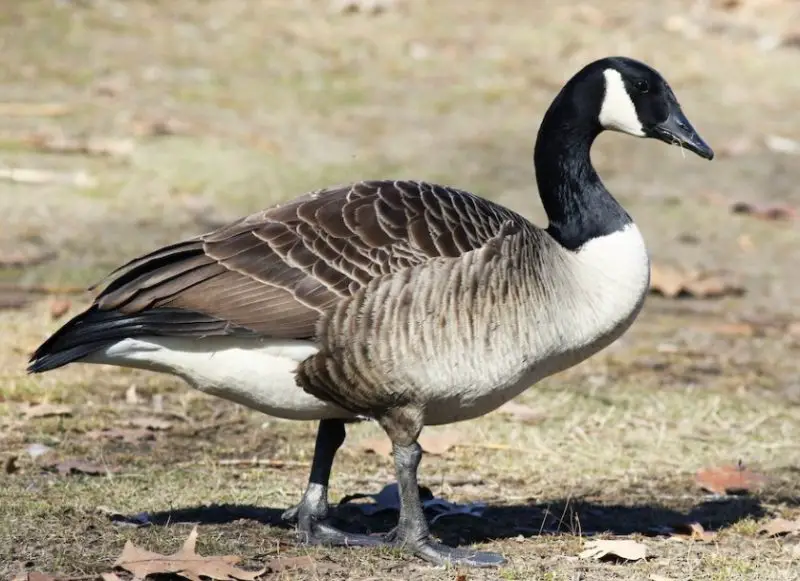
The Canada Goose is a large, familiar goose with a black head and neck, white cheek patch, and brownish-gray body. It is easily recognized by its honking call and V-formation flight patterns. Subspecies vary slightly in size and shade, but all share the distinctive black-and-white facial markings.
In Louisiana, Canada Geese are less common than farther north but still appear regularly in the inland northern regions during winter. They are mostly seen in agricultural fields, reservoirs, and open wetlands. Small numbers may also overwinter in city parks or golf courses where open water and grass are available.
Canada Geese are among the largest waterfowl, measuring 30–43 inches (76–110 cm) in length with a wingspan up to 66 inches (168 cm). Their flight is powerful, and their loud honks are often heard well before the birds come into view. They are strong, long-distance migrants, though some populations are now resident year-round in parts of the country.
They feed primarily on grasses, grains, and aquatic plants. In Louisiana, wintering flocks are often seen foraging in pastures, cornfields, and wetlands. While not as numerous in the southern part of the state, their presence adds variety to the waterfowl mix in northern Louisiana.
Canvasback (Aythya valisineria)
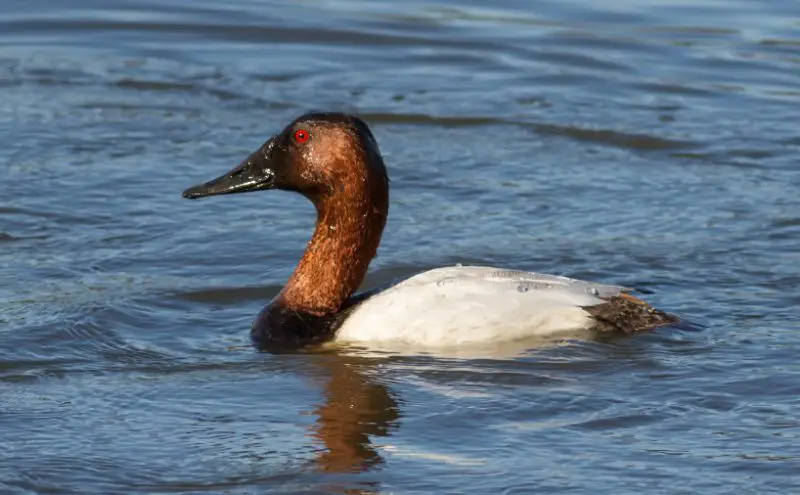
The Canvasback is a large diving duck with a distinctive sloping profile and bold coloring. Males have a deep reddish-brown head, black chest, and white body, while females are more muted with tan-brown heads and grayish backs. Both sexes have long, black bills and red eyes, making them easy to distinguish among diving ducks.
In Louisiana, Canvasbacks are seen primarily during the winter months, especially on large freshwater lakes, estuaries, and coastal lagoons. They prefer deep, open water where they can dive for food and often form flocks with other diving ducks such as Redheads and Scaup. Their presence is more common in the southeastern and coastal parts of the state.
Canvasbacks measure 19–22 inches (48–56 cm) in length with a wingspan of about 31–35 inches (79–89 cm). They are powerful fliers and divers, capable of foraging at considerable depths. In flight, their long necks and clean white backs make them easily identifiable.
Their diet consists primarily of submerged aquatic vegetation, especially wild celery (Vallisneria), from which they get their scientific name. In Louisiana, they also consume pondweeds, tubers, and aquatic invertebrates found in deeper marshes and lakes.
Bufflehead (Bucephala albeola)
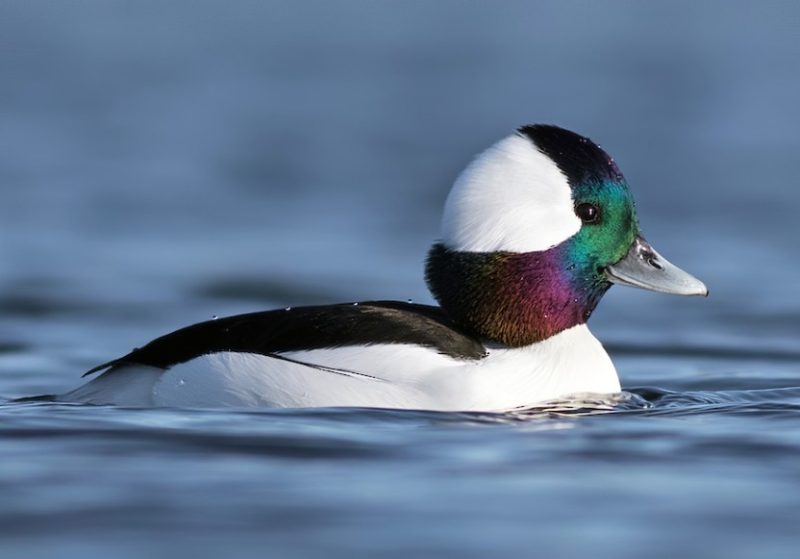
The Bufflehead is one of the smallest diving ducks in North America, easily recognized by its compact shape and striking plumage. Males have a glossy black back and head with a large white patch behind the eye, while females are dark brown with a smaller white cheek patch. The iridescent green and purple tones on the male’s head shimmer in bright light.
In Louisiana, Buffleheads are winter visitors, often seen on freshwater lakes, ponds, and brackish coastal lagoons. They tend to stay near sheltered waters and are frequently found diving near the edges of open water bodies. Although not seen in large flocks, they are common in many inland and coastal wetlands.
These ducks are small, measuring only 13–16 inches (33–41 cm) long with a wingspan of 21 inches (53 cm). They fly fast and low over the water and can take off with quick, direct wingbeats. Buffleheads are agile underwater, using their feet to chase down prey in shallow to moderately deep water.
Their diet consists mainly of aquatic insects, small crustaceans, and mollusks. In Louisiana, they forage actively in marshes and quiet backwaters, often diving repeatedly in the same area. Their energetic feeding behavior and attractive plumage make them a favorite among birdwatchers.
Greater Scaup (Aythya marila)
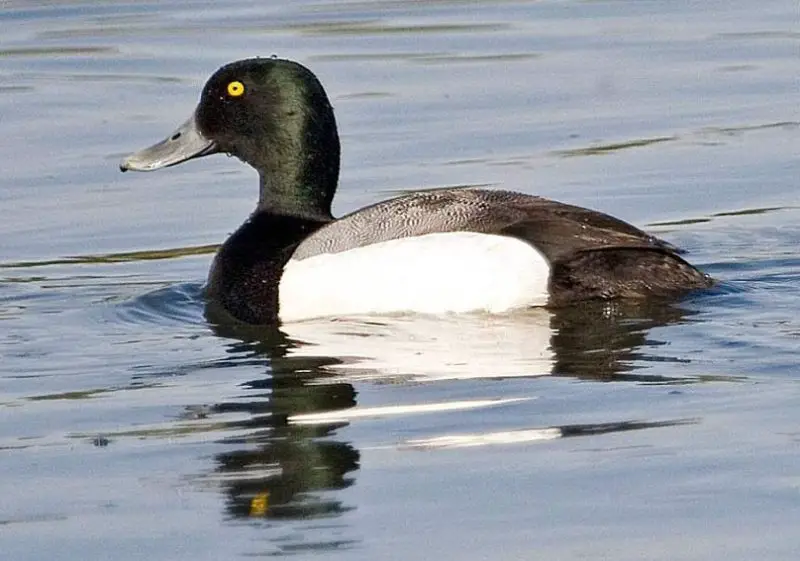
The Greater Scaup is a medium-sized diving duck that closely resembles the Lesser Scaup, but is generally larger and has a rounder head. Males are black and white with a bright green sheen on the head, while females are brown with a white face patch. One of the key differences is the broader, more rounded head profile in the Greater Scaup.
In Louisiana, Greater Scaups are winter visitors, usually seen in coastal waters and estuarine environments. They are less common than Lesser Scaups but still occur regularly, especially in saltwater bays and along barrier islands. They often form mixed flocks with other diving ducks.
Greater Scaups measure about 18–20 inches (46–51 cm) in length and have a wingspan of 30–32 inches (76–81 cm). Their flight is strong and fast, and they often take off in synchronized groups. They are strong divers, capable of foraging at deeper depths than many dabbling ducks.
Their diet includes mollusks, crustaceans, and aquatic plants. In Louisiana, they feed primarily in saltwater habitats, diving to the bottom to collect shellfish and plant matter. They are particularly dependent on healthy estuarine ecosystems where food is abundant.
Red-breasted Merganser (Mergus serrator)
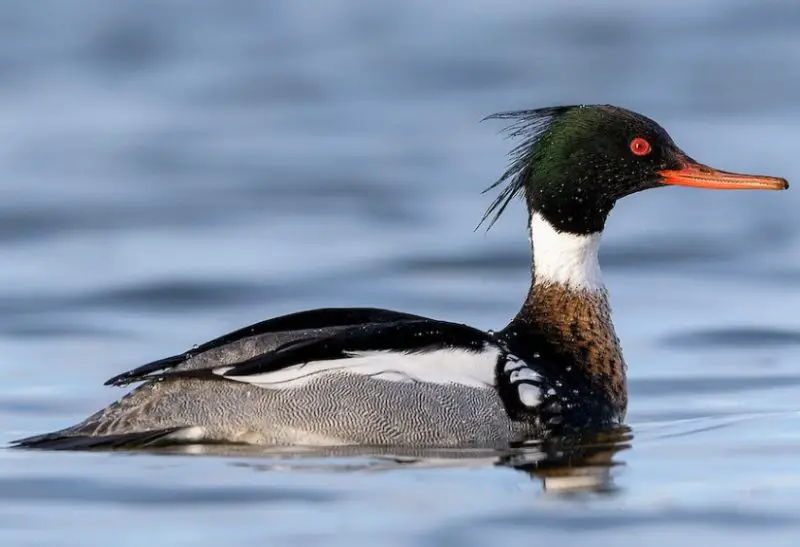
The Red-breasted Merganser is a slender diving duck known for its spiky crest and narrow, serrated red bill, which is ideal for catching fish. Males have dark green heads, rusty breasts, and gray bodies, while females are grayish-brown with rusty heads and shaggy crests. Both sexes have bright red eyes and swift, low flight.
In Louisiana, Red-breasted Mergansers are commonly found in coastal bays, inlets, and estuaries during winter. They are less common inland but can sometimes be seen in larger lakes and rivers near the Gulf. These birds prefer open water and are rarely found in vegetated wetlands.
These mergansers are medium to large in size, measuring 20–24 inches (51–61 cm) in length with a wingspan of about 30–34 inches (76–86 cm). They are among the fastest flying ducks and are capable of diving with great agility. Their flight is low and direct, often hugging the water surface.
Their diet is almost entirely fish-based, although they also eat small aquatic invertebrates. In Louisiana’s coastal waters, they are often seen diving repeatedly, surfacing with small fish in their narrow bills. Their sleek shape and efficient hunting behavior make them well-suited to saltwater environments.
Hooded Merganser (Lophodytes cucullatus)
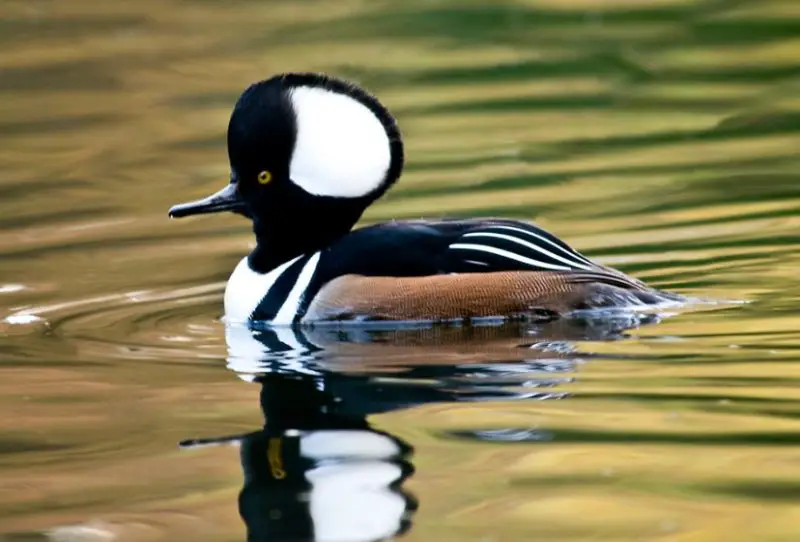
The Hooded Merganser is a small, eye-catching diving duck known for its distinctive fan-shaped crest. Males have a striking black-and-white head with a large white patch, black back, and chestnut flanks. Females are brown with a cinnamon-colored crest and yellow eyes. Both sexes can raise or lower their crests depending on behavior.
In Louisiana, Hooded Mergansers are found primarily in freshwater environments during the winter months. They favor wooded ponds, cypress-tupelo swamps, and slow-moving rivers. These ducks are often shy and tend to avoid open water, making them easier to spot in quieter forested wetlands.
They are relatively small ducks, measuring about 16–19 inches (41–48 cm) long with a wingspan of 23–26 inches (58–66 cm). Their flight is rapid and whistling, often seen weaving through wooded river corridors. They are highly maneuverable both in the air and underwater.
Hooded Mergansers eat small fish, aquatic insects, and crustaceans. In Louisiana, they dive in shallow wooded ponds and swamps, using their excellent underwater vision to spot prey. Their preference for secluded, forested wetlands makes them one of the most visually distinctive and sought-after ducks for birdwatchers in the region.
Muscovy Duck (feral) (Cairina moschata)
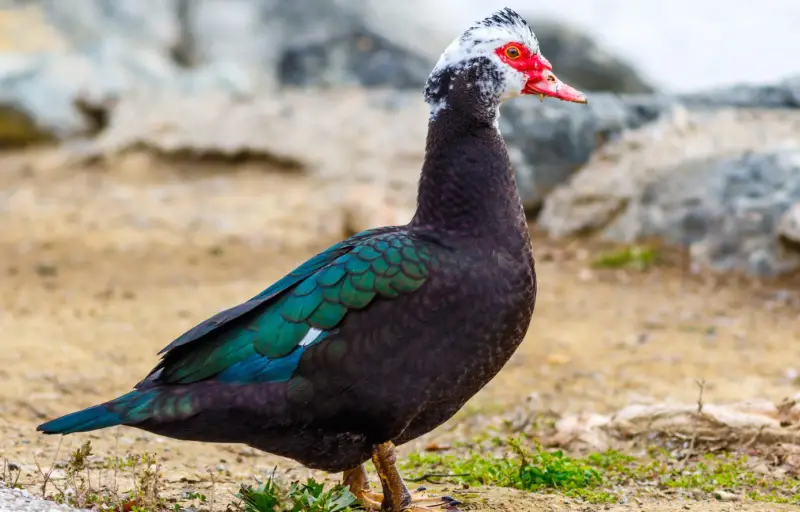
The feral Muscovy Duck is a large, domesticated-origin duck that has established wild populations in many parts of the southern United States, including Louisiana. It has a distinctive appearance with a heavy body, long neck, and red, warty facial skin. Plumage varies, but many individuals are black-and-white with an iridescent green sheen on the wings.
In Louisiana, feral Muscovy Ducks are commonly found in urban and suburban areas, as well as on farms and near canals. Though not native, they have adapted well to both human-altered and natural habitats, especially where food is available. They often congregate in parks, drainage ditches, and slow-moving streams.
These ducks are quite large, measuring 26–33 inches (66–84 cm) in length with a wingspan of about 54 inches (137 cm). Despite their size, they are capable of flight, though most feral birds are less mobile. They are generally quiet but make occasional hissing or low chattering sounds.
Their diet is highly varied, including grains, plants, insects, and food scraps. In Louisiana, they are often seen foraging on lawns, in shallow water, or near garbage bins. While not officially counted among native waterfowl, feral Muscovies are a familiar sight in many communities..
White-fronted Goose (Anser albifrons)
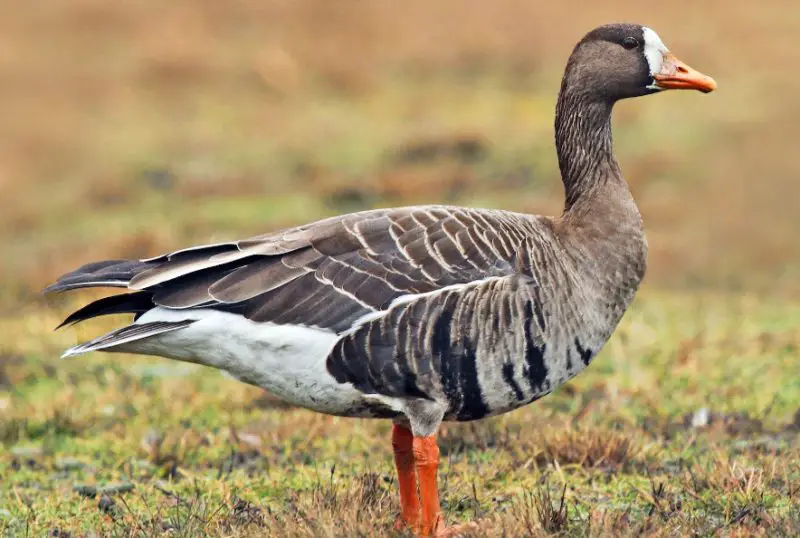
The White-fronted Goose, also known as the “Specklebelly,” is a medium-sized gray goose named for the white patch at the base of its bill. Adults have mottled black bars across their belly, orange legs, and a pinkish bill. They are often vocal, emitting a distinctive high-pitched laughing call during flight.
In Louisiana, White-fronted Geese are common winter visitors and often gather in large flocks in pastures, rice fields, and wetlands. They are especially abundant in southwestern Louisiana, where rice farming provides excellent feeding grounds. These geese are typically seen in mixed groups with Snow and Ross’s Geese.
They measure around 25–32 inches (64–81 cm) in length with a wingspan up to 55 inches (140 cm). Their flight is steady and direct, and they often arrive in Louisiana in large numbers beginning in late fall. On the ground, they graze and rest in open fields during the day.
Their diet includes grasses, grains, and aquatic vegetation. In Louisiana, they primarily feed in agricultural areas, especially rice and winter wheat fields. Their adaptability and large flocking behavior make them a prominent sight across much of the state’s wetland and farmland landscapes during the colder months.
Ross’s Goose (Anser rossii)
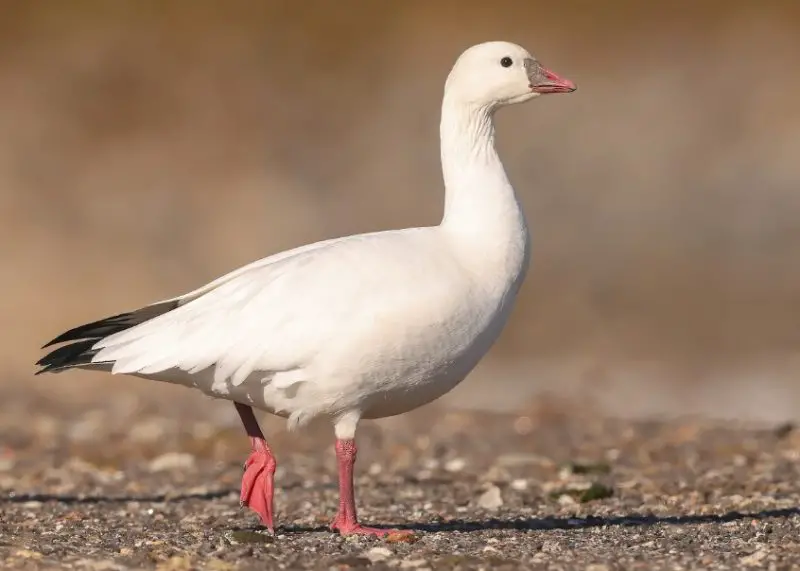
Ross’s Goose is a small white goose with a compact body, short neck, and stubby pink bill. It closely resembles the Snow Goose but is noticeably smaller and lacks the black “grinning patch” on the bill. There is also a blue morph, which is less common, featuring a dark gray body and white face.
In Louisiana, Ross’s Geese are winter visitors and typically travel in mixed flocks with Snow Geese. They are often found in the same rice fields, wetlands, and agricultural areas, especially in central and northeastern parts of the state. Though not as numerous as Snow Geese, their numbers have been increasing.
Ross’s Geese measure about 22–25 inches (56–64 cm) in length with a wingspan of 45–50 inches (114–127 cm). They fly in tight formations and are swift and agile in the air. On the ground, they are often indistinguishable from Snow Geese at a distance without binoculars.
Their diet consists of grasses, sedges, and waste grain. In Louisiana, they forage in harvested rice fields and shallow wetlands. Their small size allows them to move easily through dense vegetation, and they often accompany larger geese while feeding or roosting.
Wood Duck (Aix sponsa)
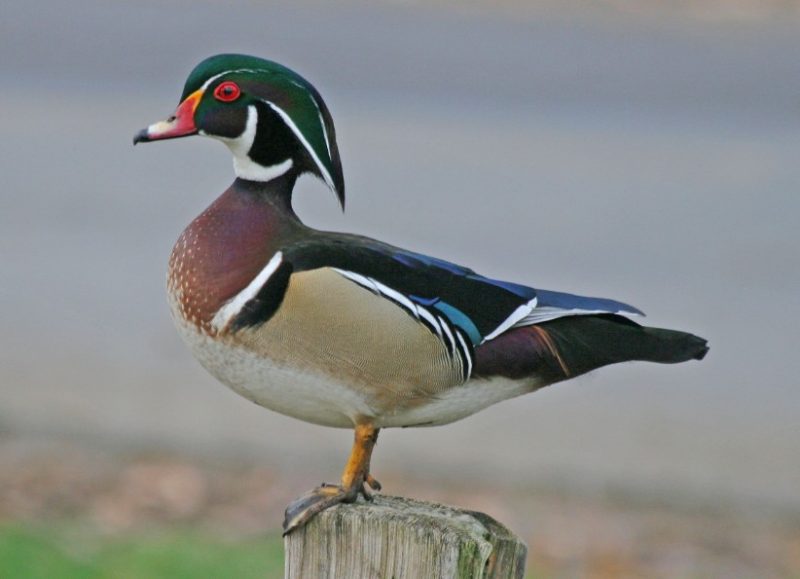
The Wood Duck is one of the most strikingly colorful ducks in North America. Males have an iridescent green and purple head, white face markings, and chestnut breast, while females are gray-brown with a white eye ring and crest. Both sexes have a long, squared tail and a unique profile in flight and on the water.
In Louisiana, Wood Ducks are found year-round, particularly in wooded wetlands, cypress swamps, and backwater sloughs. They prefer calm, forested bodies of water where they can nest in tree cavities or nest boxes. Unlike many ducks, they often perch in trees and are rarely seen in open agricultural fields.
They are medium-sized ducks, about 18–21 inches (46–53 cm) long with a wingspan of 26–29 inches (66–74 cm). Their flight is swift and erratic, especially in wooded areas. The males have a high-pitched whistling call, while females produce a soft, rising squeal.
Wood Ducks feed on acorns, seeds, fruits, aquatic plants, and small invertebrates. In Louisiana, they forage in flooded forests and near the edges of ponds and streams. Their preference for wooded, vegetated habitats makes them one of the most iconic and easily recognized ducks in the region.
FAQ about Waterfowl in Louisiana
What types of waterfowl can be found in Louisiana?
Louisiana hosts a wide variety of waterfowl including ducks, geese, and mergansers. Common species include the Mallard, Mottled Duck, Canvasback, Lesser Scaup, Snow Goose, Canada Goose, Wood Duck, and various whistling ducks. Many of these species are migratory visitors in winter, while some like the Mottled Duck and Black-bellied Whistling Duck reside year-round.
When is the best time to see waterfowl in Louisiana?
The best time to observe waterfowl in Louisiana is during the fall and winter months, especially from November through February. This period corresponds with migration and wintering seasons when large flocks gather in wetlands, lakes, coastal bays, and flooded agricultural fields across the state.
Where are the prime habitats for waterfowl in Louisiana?
Waterfowl in Louisiana are commonly found in freshwater marshes, coastal estuaries, flooded rice fields, lakes, and rivers. Key locations include the Mississippi River Delta, Atchafalaya Basin, coastal marshes along the Gulf of Mexico, and the extensive agricultural wetlands in southwestern Louisiana.
Are there any native waterfowl species in Louisiana?
Yes, the Mottled Duck is a native species that lives year-round in Louisiana’s coastal marshes and wetlands. Other species like the Black-bellied Whistling Duck are also native and have established resident populations in the state.
What do waterfowl in Louisiana typically eat?
Waterfowl diets vary by species but generally include aquatic plants, seeds, grasses, insects, crustaceans, and small fish. Dabbling ducks often feed on surface vegetation and seeds, while diving ducks consume more underwater plants and invertebrates. Mergansers specialize in fish.
Are there any conservation concerns related to waterfowl in Louisiana?
Yes, habitat loss from wetland drainage, pollution, and coastal erosion threatens many waterfowl species. Additionally, hybridization between native Mottled Ducks and feral Mallards poses a conservation challenge. Conservation efforts focus on protecting wetlands, managing hunting, and restoring habitats.
Can I hunt waterfowl legally in Louisiana?
Louisiana allows regulated hunting of many waterfowl species during specific seasons. Hunters must follow state regulations, obtain proper licenses, and respect bag limits. Popular hunted species include Mallards, Gadwalls, Teals, and Geese.
How do migratory waterfowl benefit Louisiana’s ecosystem?
Migratory waterfowl contribute to wetland health by helping control insect populations, spreading seeds, and supporting nutrient cycling. Their presence also supports ecotourism and hunting industries, which have economic importance for the state.

